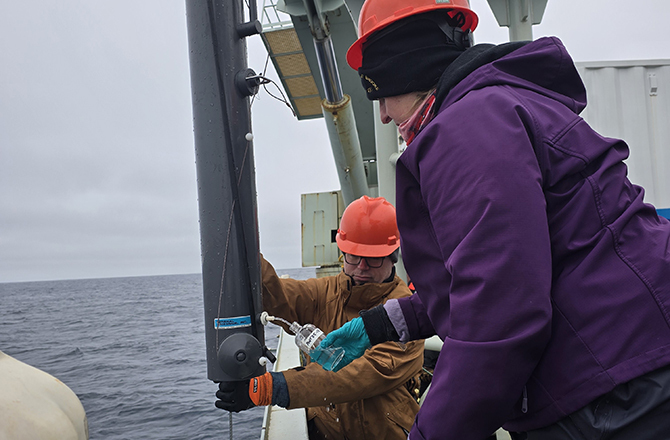First ever all-Canadian expedition to Antarctica
Profile of Alexandra (Sandy) Steffen and Geoff Stupple
First ever all-Canadian expedition to Antarctica

Sandy Steffen and Geoff Stupple, two scientists who specialize in atmospheric pollution, took part in the first Canadian-led scientific/Navy expedition to Antarctica. This unprecedented mission took place in February and March 2025 aboard His Majesty's Canadian Ship (HMCS) Margaret Brooke, with 15 Canadian scientists on board. Their goal was to document the effects of climate change, glacier retreat, species distribution, ocean currents and pollution by mercury, persistent organic pollutants, and microplastics.
“This experience was fascinating in so many ways!” says Sandy. “We had many tasks: most of them related to our expertise in mercury, but we also wanted to collect useful samples for our colleagues’ scientific projects in contaminants.”
We have been running our airborne mercury research program for 30 years. We have the longest mercury atmosphere record in the world.
Sandy has been leading the atmospheric mercury program for 22 years and Geoff is celebrating his 10th anniversary with the team, a shared experience that is second to none. They spend most of their year conducting similar studies in the Arctic. Their recent mission near the South Shetland Islands will provide a better understanding of Antarctica's environmental challenges and how they relate to the Canadian Arctic. Changes in the polar regions are happening faster than elsewhere on the planet, so it is important to take a close look at both the Arctic and the Antarctic to find answers.

Understanding the planet's health
For two weeks, Sandy and Geoff took samples of air, water, snow, sediment, and zooplankton to detect the presence of various pollutants. “In some of the work, we were trying to understand the impact of melting glaciers on the distribution of contaminants,” says Sandy. “As well, our colleagues collected sediments for us to help locate these substances in the ecosystem. We collected ocean zooplankton to determine the presence of mercury and microplastics.”
Most of the samples were brought back in Canada, but instruments on board the ship collected mercury in the air in real time for their atmospheric study. “We found that mercury levels in this southern region are about 30% lower than those we found in the north,” says Geoff, “and why we see the difference is primarily because there is more industrial activity in the northern atmosphere than in the southern atmosphere.”
The two scientists took water samples near various glaciers along their route. Glaciers are excellent reservoirs: they collect pollution from the atmosphere that has entered these glaciers and are frozen in time. Melting glaciers release these contaminants. “We're trying to see if the contaminants are showing up in the meltwater and eventually getting into the ocean through this pathway,” says Sandy.

The new data collected will be crucial for understanding the dynamics of contaminants in the atmosphere and ocean currents. Sandy adds that “microplastics are still not well understood around the world, and we don't know their full impact yet. In Antarctica, we were trying to determine their presence in the environment, as they’re not supposed to be there. We’re studying how they enter the environment and what types of microplastics are present.”
An unprecedented experience
Sandy and Geoff had some surprising adventures, as it’s not every day they get the chance to travel aboard a ship designed for operations in polar regions and extreme climates. “I didn't expect it to be so windy,” exclaims Sandy. “It would shift in the blink of an eye, and we'd go from 10 to 40 knots in the space of half an hour!”
This increased the challenge for Geoff, who was responsible for collecting samples from the coast in a Zodiac, even in stormy weather. Fortunately, everything went off without a hitch, and they have nothing but happy memories.
Geoff handled most of the samples on the coast as he was responsible for leading the snow sampling. I was in charge of water sampling from the small boats.
Promising projects for the future
Back home, Sandy and Geoff have their work cut out for them. They will work with other ECCC scientists to understand the cycling of contaminants in this environment. Departmental colleagues will analyze the collected water, snow, and zooplankton samples to see how far pollutants travel in the most remote regions.
Their mission to Antarctica also paved the way for future work and new regional collaborations with other researchers. “We visited other countries' Antarctic stations,” they added. “Part of the work we had planned was to install samplers for year-long measuring of mercury and persistent organic compounds in the air. We met scientists at their research centres and worked together to install these samplers.”
Most of their future work will take place in the Arctic. In June, Geoff will be heading off on a mission to Alert, Nunavut, Canada's northernmost station, to continue his research into how contaminant movements evolve with climate change. “We're Arctic researchers who want to learn from Antarctic researchers,” Geoff concludes, “and understand the differences between these two contrasting regions.”